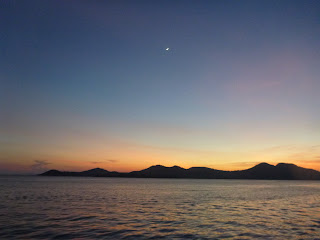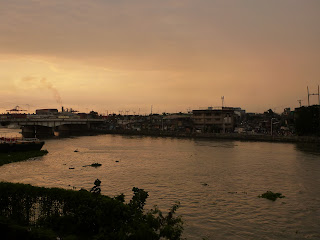I dedicated this day almost entirely to the National Museum of Anthropology in Mexico City. I had heard that the museum was huge and almost impossible to visit in its entirety in one go, so I decided to just go there in the morning and see how far I got before my head threatened to explode.
The museum focuses on all the indigenous cultures in Mexico, grouped by geographical region and time. For ease of reference, time spans were given in terms of three phases - preclassic (up to 100 AD), classic and postclassic (after 900 AD). On the ground floor, the museum had exhibits from the pre-hispanic civilizations, while the first floor had exhibits from the peoples who live in the same geographical regions today.
As I had feared, the museum was much too big. There were too many exhibits and too many explanations to read. Just have a look at the main part of the Aztec exhibition to get an impression:
Luckily, from my earlier visits to archaeological sites, I already knew about some of the cultures and didn't have to read every single bit. One new thing I learned was that in this part of the world, organized religion seems to have been invented some time between 1800 BC and 100 AD - the same period of time as in other parts of the world. Strange, isn't it?
As you would expect from a big museum in a nation's capital, they snatched up some of the best archaeological finds from around the country. For example, this was the only place in Mexico where I saw some of the old writings, called codices, on display. This is an Aztec one:
The Maya especially kept excellent records of their history, but unfortunately most of the codices were destroyed by the Spaniards. This is one of the very few remaining ones:
In the Maya section of the museum, they also had the richly adorned sarcophagus of Pakal, ruler of Palenque. But wait... hadn't I seen that sarcophagus before? I had, in fact, when I was visiting
Palenque: the site museum there also had the sarcophagus. Neither of the two museums said that their version was a replica. But one of them has to be... if they care this little about fooling the public, I wonder how many exhibits in this or other museums were just replicas instead of the real thing?
The museum also displayed a great feather headdress that was supposedly worn by the last Aztec ruler
Moctezuma II when he went to greet the Spanish conqueror
Hernán Cortés:
Another part of the museum dealt with the
Olmec, considered to be the first civilization in Mexico. The biggest trademark of the Olmec were the colossal stone heads they made:
After covering all of downstairs, I went upstairs to check out the exhibition about current-day indigenous peoples. The exhibition was started with this tree, representing the diversity of today's indigenous people in Mexico:
I was already quite tired at this point in my visit, so I didn't really pay much attention to the rest of the exhibition. All I managed was to walk through, just for the satisfaction of having seen everything ;-)
After a break in the afternoon, I felt up to one more museum visit. As a contrast, I picked something small and non-historic: the Frida Kahlo museum. The museum is located in a house called Casa Azul, which was the home of
Frida Kahlo and her husband
Diego Rivera for many years.
The museum had some rooms with artwork created by Frida and Diego, and a few more rooms exhibiting personal items from their lives. Especially Frida's life is quite a tragic story - I suggest you watch the movie
Frida if you want to know more.
In the evening, I strolled around in the vicinity of the Zócalo to find something to eat. A short while after I had sat down in a restaurant, a demonstration went down the street just outside the window I was sitting at. The people, mostly the younger half of the population, were demonstrating against the planned labor law reform.
The labor laws are apparently decades old and in definite need of reform; but as with governments worldwide, the Mexican one doesn't seem to have the the common laborer's interests in mind. The reform is supposed to combat unemployment and create new jobs, but people fear that all it will do is outsource jobs and lower salaries.
When I had finished eating, I went down the street to look at the demonstration's aftermath. It seems that the police had covered all the building facades with metal sheets - certainly in anticipation of people spraying slogans on every flat surface available.
The demonstration was still ongoing when I arrived at the Zócalo. Everyone was listening to someone giving a speech in front of the brightly lit government palace.
If you don't look closely, you might think that there was an Italian flag flying over Mexico City. Indeed, when I first came to Mexico and was looking for a restaurant I had wondered about the multitude of 'Italian' restaurants - and the lack of Mexican ones. Later on, I learned that the colors in the Mexican flag are darker than the Italian ones, the proportions of the flag are different, and, of course, there is the Mexican coat of arms in it. But apart from that, the two flags really do look similar ;-)





















































